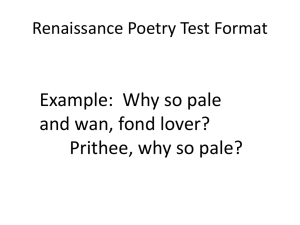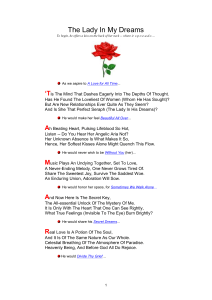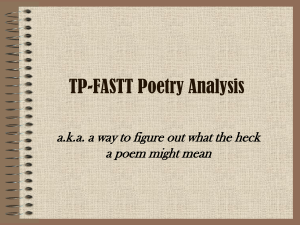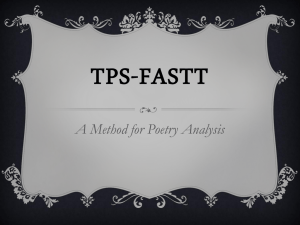Poetry TPFASTT - Valley View High School
advertisement
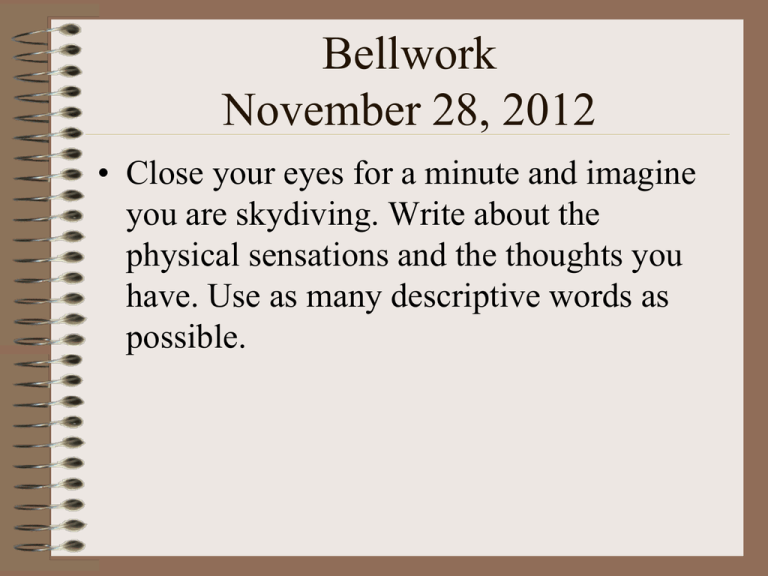
Bellwork November 28, 2012 • Close your eyes for a minute and imagine you are skydiving. Write about the physical sensations and the thoughts you have. Use as many descriptive words as possible. Leah ..the little puppy Poetry Analysis Using TPSFASTT Getting Started… • This is a process to help you organize your analysis of poetry. • You have already learned the vocabulary, now it’s time to put it into practice! • Together, we are going to analyze “Dreams” using TPFASTT. • You will be given a note sheet to use as we analyze the poems. Add your analysis of “Dreams” to the TPFASTT sheet as we go through each slide T is for TITLE • Analyze the title first. • What do you predict this poem will be about? • Write down your predictions. • We will reflect on the title again after we have read the poem. • The next step is often omitted, but it is the most important!!!! READ THE POEM!!!! Dreams Hold fast to dreams For if dreams die Life is a broken-winged bird That cannot fly. Hold fast to dreams For when dreams go Life is a barren field Frozen with snow. -Langston Hughes P is for PARAPHRASE • Paraphrasing is putting something in your own words. • After reading the poem, rewrite it in your own words. • This may be three sentences or a page, depending on the particular poem. S is for Speaker • The speaker of the poem is different from the Poet. • Answer the question: “Who is speaking in this poem?” • The choice of speaker should be supported by evidence from the poem. • It can be someone specific ( King Arthur) or someone general ( a dragon/ a wise old man). F is for Figurative Language • Analyze the figures of speech and sound effects of the poem. • Look for literary devices such as imagery, symbolism, metaphor, simile, personification, and effects of sound (alliteration, rhyme, etc.). Bellwork November 29th: You are staying with your grandparents on vacation and you wander up to the attic one day. You find an old worn out trunk that has been pushed in a corner of the room. It is ornately decorated with spirals and loops carved into the wood. You open the trunk and find…. Write about what you find in 7-10 sentences. A is for ATTITUDE • Tone is the attitude of the speaker toward the subject of the poem. Use adjectives to describe tone. • Ex: desperate, happy, judgmental, thoughtful, depressed, etc. • You must have evidence to support your choice. S is for SHIFT • If there is a change in… – Time – Tone – Speaker This should always be noted as this will also affect the meaning. Look for: shift words (but, yet, then, etc.) and punctuation T is for TITLE (again) • At this time, you should reconsider the title. • Were you right in your predictions? • What other meanings might the title have in light of your analysis? • Next, the biggie…. T is for THEME • Theme is the general insight into life conveyed by the author through his/her work. • It does not make a judgment. example: “Don’t do drugs” is not a theme. • It merely states something that is true to life and the human condition. • First list what the poem is about, then determine what the poet is saying about the subject. How do I find the THEME? • Look at the other parts of TPSFASTT. • What insight are all of these working together to convey? • What is the poet trying to say about life? Eadms Test • We are taking this test to gauge our current ability to pass the CAHSEE. Do your best on this exam to give me, your tenth grade teacher team, and Mrs. Hunter and idea of what needs to be reviewed for you to pass the exam next semester. Homework • TPSFASST ( on a lined sheet of paper) “Nothing Gold Can Stay” by Robert Frost. • Due Tomorrow. Poetry Discovery Discussion • Take out your homework so we can discuss it.



